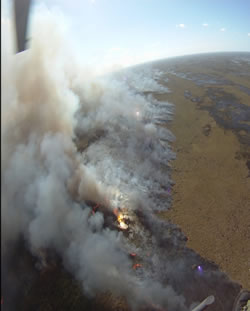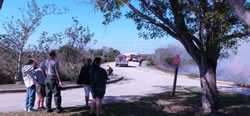National Cohesive Wildland Fire Management Strategy Success Story
31,000 Acre Prescribed Burn Reduces Hazardous Fuels, Fights Exotic Species
Everglades National Park, Florida
Cohesive Strategy - Maintain and Restore Landscapes
2012

Most of the ignition for this burn was conducted by helicopter.

At Shark Valley, park rangers explained fire ecology while visitors watched firefighters burn along roads and next to buildings.
On November 29 and 30, 2011, firefighters at Everglades National took advantage of favorable winds and high water levels to conduct a 31,000 acre prescribed burn adjacent to Highway 41, between Canal L67 and the highly popular Shark Valley Visitor Center.
Like most prescribed burns, the River of Grass Northeast burn had multiple objectives. First, the burn reduced flammable vegetation that had built up along Highway 41 and Canal L67 since the last time this area burned in the 1960s. Two wildfires in August 2011, the Afternoon Fire and the Shanty Fire, burned along the highway and threatened numerous economic developments, including airboat concessioners, tribal neighbors, and the Miccosukee Casino. Those fires underscored the urgent need for a fuel reduction burn in this area. In addition, areas burned by those fires provided a secure perimeter for the River of Grass burn.
The second purpose of the burn was to complete a three-phase melaleuca control program that began with chopping down the trees, then spraying the stumps with herbicide before burning the resprouting saplings of this invasive exotic species.
Finally, the burn helped return this part of the Everglades to its natural 3-year fire return interval, benefitting fire-adapted native species.
For coverage of the burn on the Miami CBS affiliate web site, see Everglades Prescribed Burn Generating Significant Smoke. Video of the burn is posted on the park Facebook page.
Contact: Rick Anderson, Everglades Fire Management Officer, rick_anderson@nps.gov, (305) 242-7853.